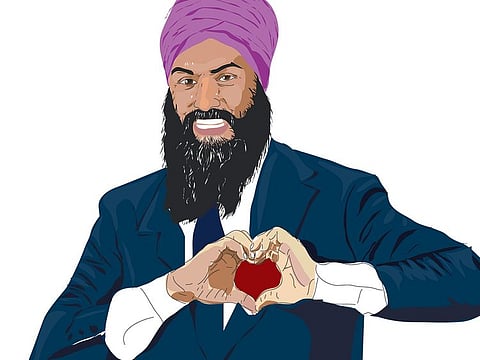Newsmaker: How Jagmeet Singh is winning voters’ hearts in Canada
Singh captured voters’ imagination in Canada as first person of colour to lead a party

Almost two years ago, when Jagmeet Singh was still the rookie leader of Canada’s left-leaning New Democrats and unknown to most Canadians, the party’s headquarters sent out a press invite to Toronto’s media, asking them to attend a suburban banquet hall for an important announcement. There Singh stood before the assembled press corps, produced a ring, went down on one knee and proposed to his long-time fiancee, Gurkiran Kaur. She’s a fashion entrepreneur.
She said yes to the former criminal lawyer who turned 40 this year — the first person from an ethnic minority background to lead a major political party in the nation of 37 million.
In multicultural Canada — where immigration is at its highest level in years and 321,000 new arrivals landed in 2018 alone — anything is possible.
Over the past six weeks, Singh has been selling the NDP message of equality, opportunity and a cleaner, greener future to Canadian voters on the campaign trail. When the votes were counted into the early morning hours of last Tuesday, Singh’s party emerged with 24 members of parliament — enough to hold the balance of power in House of Commons in Ottawa where Prime Minister Justin Trudeau and his Liberals fell 13 seats of a majority of 170 seats.
From a narrow party perspective, Singh’s leadership saw it decline from 37 seats in the previous parliament. Given a resurgent Bloc Quebecois in Quebec — the French-speaking province where the NDP out-performed four years before — and surging support for the Greens as a result of growing concern over climate change and the environment, analysts had expected the NDP to be reduced to a dozen or so seats. In taking 24, Singh’s party exceeded expectations, winning 15.9 per cent popular support.
Trudeau’s Liberals and the NDP have much in common when it comes to progressive and social policies — they converge when it comes to offering Canadians cheap or free medication to go with their free health coverage and the environment.
A significant voting bloc
For Singh, supporting the Liberals is an act of political engagement that’s a no-brainer — just as it was popping the question to Kaur. They were married early this year, a month before the NDP leader won his seat in a Burnaby South by-election. He easily retained the British Columbia seat on Monday.
Across Canada, there are almost equal numbers of Sikhs and Hindus. Together, the 1.4 million strong communities provide a significant voting bloc on which to build support, one that has been traditionally loyal to Canada’s Liberals. Singh has changed that and earned the support of many Canadians who admired his optimistic outlook, and fresh approach as he campaigned in a bright orange, pink or cobalt-blue turbans.
Sure, it might look now as if Singh is on easy street — but it wasn’t always like that.
Jagmeet Singh Jimmy Dhaliwal was born in Scarborough in January 1979. It’s a suburb to the north east of Toronto commonly referred to as “Scarberia” for its vastness and chilling social isolation. His parents, Marmeet Kaur from Ghurandi Khurd in Punjab’s Ludhiana district and Jagtaran Singh from Thikriwala in Bamala district, were new to Canada and struggling to make ends meet. Singh’s psychiatry degree was not recognised in Canada, and he worked as a security guard as he requalified. The young Singh was packed off back to India before the family could be re-united first in St John’s Newfoundland and later in Windsor, on the Ontario side of the US border with Detroit, Michigan.
Gaining notoriety
After completing high school, Singh went on to get his Bachelor of Science from the University of Western Ontario, then a Bachelor of Laws from York University in 2005, then called to the bar a year later.
He specialised in criminal law and also became active in politics, perhaps influenced by the role played his grandfather, Sewa Singh Thikriwala, in fighting British rule in India during the last decade of the Raj. He gained notoriety in the Sikh community for leading opposition to the visit of then Indian Trade Minister Kamal Nath and his role in riots in Delhi in 1984. He used that as a springboard to run in the Brampton area as a candidate in the 2011 federal election, losing narrowly. Within months, he won a seat in Ontario’s provincial legislature.
Under the leadership of Jack Layton, a charismatic and popular Toronto MP, the NDP seemed set for a breakthrough on the national stage. His untimely death after a long and public battle with cancer in 2011 led to a period of introspection in party ranks. Thomas Mulcair emerged as NDP leader — but against the popular appeal of Justin Trudeau as a fresh-faced young politician, he appeared stale and uninspiring. When Mulcair did step aside, Singh ran for the leadership. His enthusiasm brought 40,000 new members and he easily won the leadership with 54 per cent support in the first round of voting two years ago.
It took another five months for the New Democrat leader to enter parliament in that Burnaby South by-election. Following last week’s election, it certainly seems as if he’ll be centre stage now in Ottawa for the next four years.
Sign up for the Daily Briefing
Get the latest news and updates straight to your inbox



